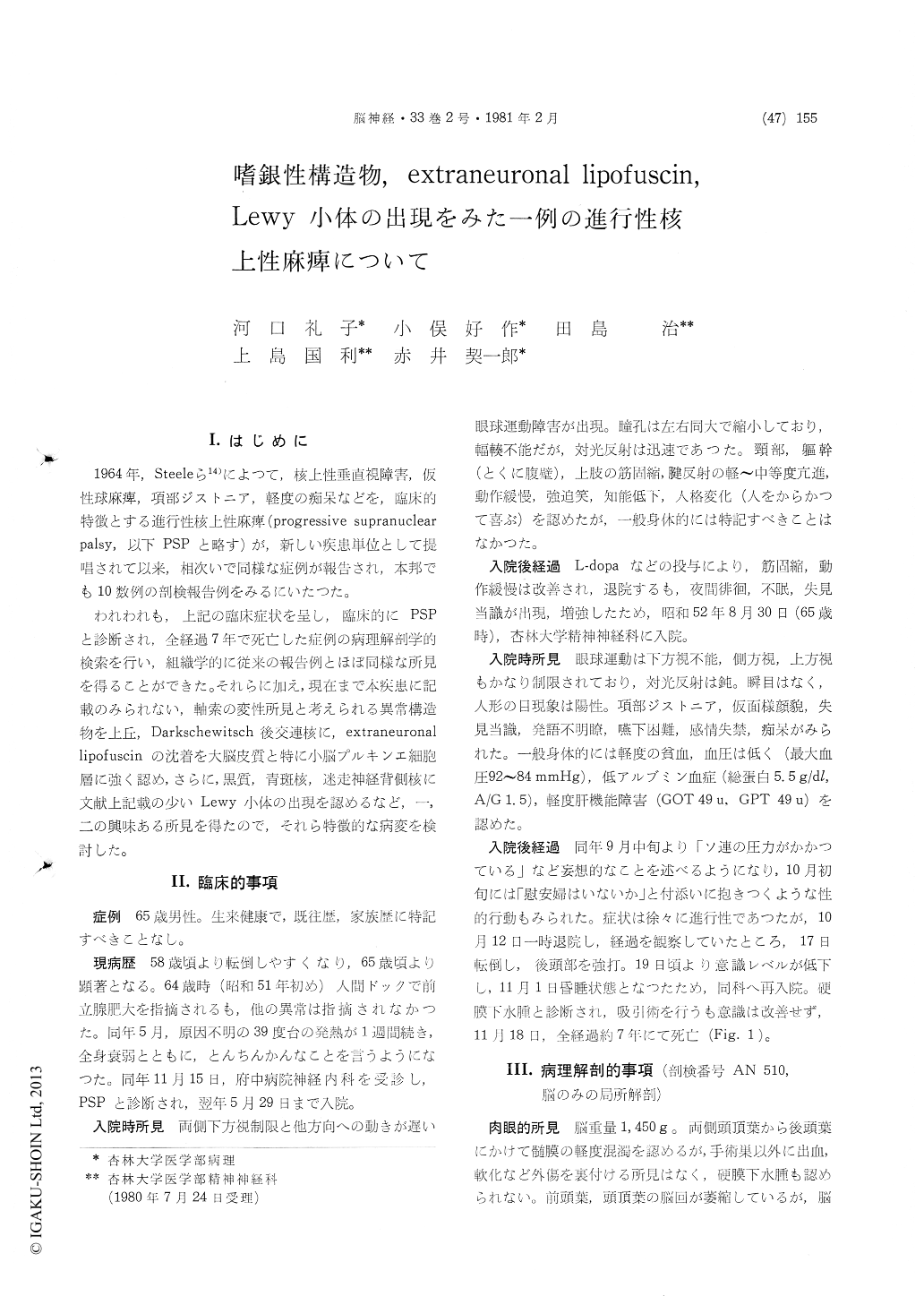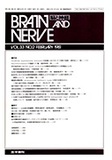Japanese
English
- 有料閲覧
- Abstract 文献概要
- 1ページ目 Look Inside
I.はじめに
1964年,Steeleら14)によつて,核上性垂直視障害,仮性球麻痺,項部ジストニア,軽度の痴呆などを,臨床的特徴とする進行性核上性麻痺(progressive supranuclearpalsy,以下PSPと略す)が,新しい疾患単位として提唱されて以来,相次いで同様な症例が報告され,本邦でも10数例の剖検報告例をみるにいたつた。
われわれも,上記の臨床症状を呈し,臨床的にPSPと診断され,全経過7年で死亡した症例の病理解剖学的検索を行い,組織学的に従来の報告例とほぼ同様な所見を得ることができた。それらに加え,現在まで本疾患に記載のみられない,軸索の変性所見と考えられる異常構造物を上丘,Darkschewitsch後交連核に,extraneuronallipofuscinの沈着を大脳皮質と特に小脳プルキンエ細胞層に強く認め,さらに,黒質,青斑核,迷走神経背側核に文献上記載の少いLewy小体の出現を認めるなど,一,二の興味ある所見を得たので,それら特徴的な病変を検討した。
Since past one decade more than ten autopsied cases of progressive supranuclear palsy have been reported in this country and our knowledge on pathological alteration of this disease has been remarkably increased. A case presented here reveals some additional histologic features which have not been appeared up to now.
A case studied is a 65-year-old man with seven years of clinical history of progressive supranuclear palsy characterized by paralysis of down and upward gaze, inability of eye convergence, loss of reaction to light, severe muscular rigidity with upturned posture of the head, mask-like face, hyperflexia and slight dementia.
Examination of the brain weighing 1,450gm. reveals there is no significant change with naked eye except a slight atrophy with moderate symmet-rical dilatation of the bilateral ventricles.
Lightmicroscopic examination discloses moderate neuronal loss, astrocytic gliosis and prominent neuro-fibrillary change, mostly globose type, in the re-maining nerve cells in the putamen, subthalamic nucleus, Darkschewitsch's and Cajal's nuclei, sub-stantia nigra, locus ceruleus and inferior olivary nucleus and also shows severe grumose degenera-tion of nerve cells in the dentate nucleus of cere-bellum. A senile plaque is nowhere to be found. In addition to these common findings seen in this disease, following noteworthy changes are encoun-tered.
In superior colliculus several abnormal structures, akin to cactus-like degeneration, which are irregular in shape and size measuring 45 to 70μm. in diameter are recognized in the stratum zonale and cinereum. A representative one of them consists of several spherical or oval bulging with radiated thin fibers and contains fine fibrills inside either network or straight fashion shwoing strongly argyrophilic in the nature with Bodian's stain and is surrounded by thin myelinsheath-like structure which is faintly stained with Luxol fast blue as seen in Figs. 4. Exact origin of its structure has not been deter-mined, however, because of its stainability, shape and size, it presumably might be caused by altera-tion of axons of mother cells or relay cells related to the tracts of eye movement.
In the cerebellum, a large number of coarse lipofuscin pigments are found in and around Berg-mann's glia cells between lining Purkinje's cells, not seen in the Purkinie's cells, and less seen in molecular and granular layers.
In the substantia nigra and locus ceruleus, espe-cially in the latter, small number of nerve cells which contain Lewy's bodies are noted as seen oc-casionally as such manner in high older age. The presence of these Lewy's bodies and extraneuronal pigments suggests an accelated pathological senesent process in the course of this case.

Copyright © 1981, Igaku-Shoin Ltd. All rights reserved.


